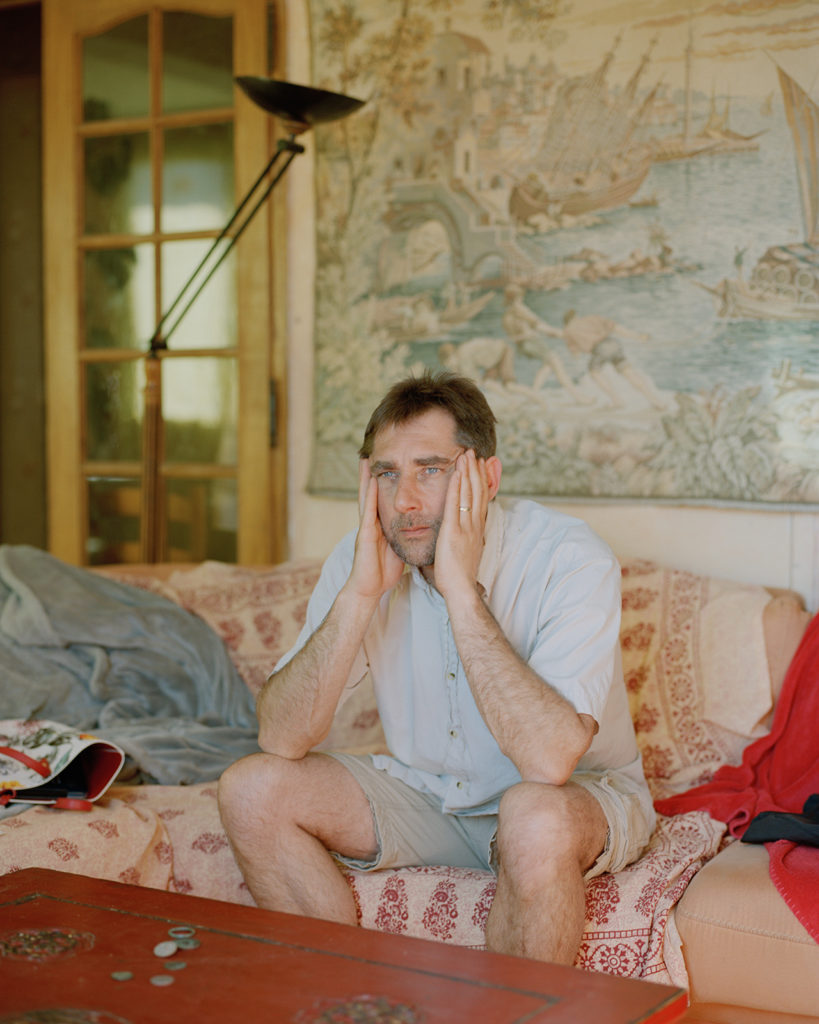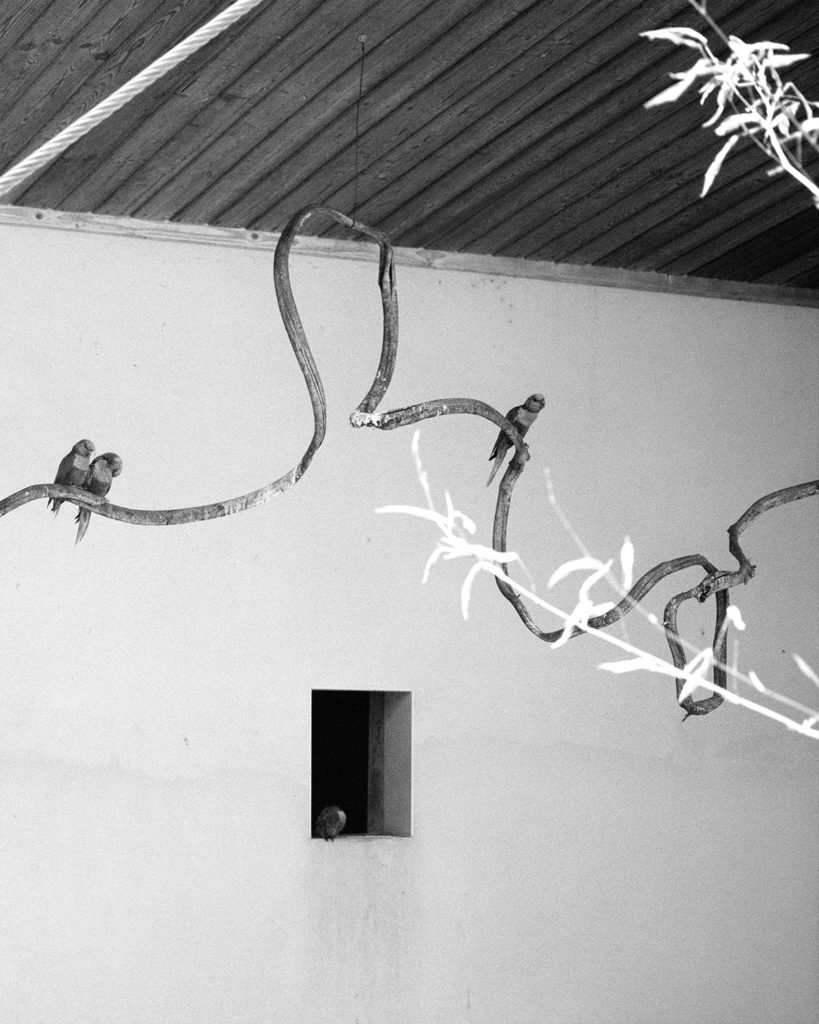Emily Graham lives in London, she works primarily with color photography and her practice often deals with elusive subject matters; a search for the unknown, a psychological state, the act of communication and interpretation. At first sight, Emily’s latest work The Blindest Man seems to be a documentary project, but gradually adds puzzling conceptual elements which are creating an inexplicable concern to the viewer. The project exists primarily as a book and until the last page, despite the unsolved treasure hunt, it has already offered us a timeless experience.
Instead of asking you about the starting point of the series I would rather ask when was the first time you felt that you are achieving what you really want to do with photography?
That’s a difficult question to answer, because the goalposts are always shifting. In a way, that feeling was there when I made a darkroom print of a particular scene, back when I was on my first photography course as a teenager, a scene that was in real life quite ordinary, but through the photograph became something different, something compelling in its own right. The feeling was more about excitement about the possibility of the medium rather than achievement – achievement can be quite an elusive feeling!
The Blindest Man is a long term project. How did you manage to keep up with this over the years? How did you approach all these people? It seems that your communication is definitely a main aspect of the project and the documentary of the treasure hunt itself is more like a pad.
When I began this project, I was looking for a framework for photographic wanderings, and I was thinking that the framework itself would be rather arbitrary. Having come across this unsolved treasure hunt, I was interested in the idea of following set routes with something specific in mind that one was looking for, and seeing where that took me. I started following searchers’ failed routes – the paths they had taken that lead nowhere, and using these as a framework for making pictures. I didn’t live in France, so I would take trips as and when I could.
After a while, I got more drawn in to reading various searchers’ theories and stories (from what I could make out online), and wanted to know more. There were forums full of arguments about different approaches – wildly different ways of looking at the same thing – and this was compelling. There’s an association of searchers dedicated to this hunt, so I joined the association and started to get in touch with people through this forum. It was easiest to arrange meetings with the most impassioned searchers – those who had invested a lot in the search. The first person I spoke with was of the opinion that there was no longer anything buried, that the search was fraudulent and was in the process of taking the author (now deceased) and his estate to court. He’d spent twenty years searching for the gold, going on trips in pursuit every vacation, at first with family and friends, later when they had tired of it, going alone. He told us he’d been back to the same site in the French alps over fifty times, dug over fifty holes, made records of every trip. Convinced his solutions were correct, the hunt was to him, flawed or fraudulent.
Each year, the association arranges a weekend ‘fête’ in which some of the most dedicated searchers meet up at a location relevant to the hunt, and spend time together theorising, socialising, running a localised treasure hunt. People would stay up late into the night arguing about their solutions, careful to share enough to discuss but not enough to give away. Though there is frustration in the not finding, there is also pleasure in the chase. There was often one person or couple who would turn up positive that they had solved the hunt (though not found the treasure), whose theories would later be taken apart by the group. I met many searchers here, and would later visit a selection of them at their homes, interviewing them about their experiences looking for this treasure.
What was really fascinating to me was the breadth of approaches to the hunt; one person has a spiritual / philosophical reading of the quest, and through it her life has become imbued with signs. Another talks of being lost in the world of the hunt, in his day-dreams of being victorious and in trying to calculate solutions, in always being on the cusp of finding the thing, how it often takes him away from his time with his family and friends. Another person has raised a court case against the family of the author (who is now deceased), to halt the search, he posits that he has the correct solutions and the game is fraudulent. There are a few more extreme stories of people losing their way (though these have been passed to me by other searchers); of someone blowing up a chapel in their search, someone attempting to dig up the foyer of a bank, someone cooking parts of the book in wine to gain clarity on the solutions.
“Photographs are slippery things – and I like working in this space – with the suggestive and metaphorical potential of photographs.”
For me, this connects to the ways in which people respond to the world, the dreams and fantasies that individuals set out for themselves, and the difficulties and frustrations they experience in realising them. As you say, the real life hunt is more like a framework for my work – I was less interested in creating a documentary about the hunt, than using the hunt as my starting point. Many people’s response was that it would make a great documentary film – but it was exactly the limitations of the photograph that I wanted to play with, to play with what wasn’t seen, and my approach to play on that of a documentary photographer. There was little to document photographically, as much of the activity of the hunt happens in the minds of the players – rather than manifests as physical activity – but there seemed to be a rich inner world connected to the search. I wanted to draw a parallel between the treasure hunter and the photographer collecting the world through photographs.
I think the parallel between the treasure hunt and the meaning of life, or better said the trip to Ithaca, is very concrete. The reader of the photobook can sense that the subjects seem to be between real life and a dream world; we encounter similar worlds in the films of David Lynch and Ingmar Bergman. Is this a main aspect of your artistic practice in general?
Thank you – I love both Bergman & Lynch’s films so I’m sure there’s a bit of that influence in there. I don’t want to attempt to be too grandiose with the work, but the hunt was a good case study for thinking about the precarious nature of pursuit and failure; I think of it as a kind of modern parable.
I’m interested in the blurred lines between fantasy and reality; how our experience presents itself to us as individuals and how that affects our understanding of the seen world. When I was making this work, I was reading Breton’s Nadja, and the surrealist methodology of finding the fantastic in the everyday and utilising chance & arbitrary connections definitely also played into my thinking about the work. I was interested in the absurdity of the search – but also the beauty within the absurdity, the ‘treasures’ of the trail, the delights of seeing.
More generally, I often work with elusive subjects; a search for the unknown, a psychological state, the act of communication and interpretation. Photographs are slippery things – and I like working in this space – with the suggestive and metaphorical potential of photographs.
What stage in the creation of this photo book did you most like?
The book is still a work-in-progress…and this is the first time that I’ve worked on my own book project so it’s been a slow and consuming process. So much of TBM comes together through the editing process, and the structure of the book is designed to create a feeling of going on a wild goose chase, not reaching the desired point, failing, having to start again. I learnt how to bind as part of this, and going through the process of making the book as a physical object repeatedly until it got closer to what felt right was really satisfying.
The Blindest Man is mainly a color work. Although some of the images are black & white; why did you choose this route?
I work primarily in colour, but when I started working on this project I was toying with using monochrome, partly as I wanted to play with the visual language of documentation and evidence. I realised pretty quickly that the work needed to be primarily in colour; I wanted the photographs to have a kind of fever dream quality to them, and colour was important to this. In trying to make work about trying to reach something that is out of reach light acts as portent, the images themselves are illusions.
At various stages in making the work I wasn’t sure if the two (b&w and colour) could work together but in the sequence of the book the monochrome images act as breakers in the edit, kind of jolting the flow of the book.
What is the relationship between a photobook and an exhibition? Which form of presentation do you appreciate the most for your own work and which form do you like to look at photography in general?
I tend to treat these as quite different spaces. With TBM I have had the book form in my mind from the beginning, as I wanted the viewer to have a reading experience with the book as an object; getting lost in the pictures in a confined space, in their own space. An exhibition is a much more open experience, and the experience of the work is influenced by other external factors; the space, the type of venue, the audience etc. When I’ve shown this work in exhibition form I’ve attempted to create an active environment of looking – creating a treasure hunt of pictures, whereby it doesn’t matter if all of the pictures are seen or not, the point is more in the looking. By contrast, the book is a tightly controlled space – in the edit and sequence of pictures, and it relies on this.
With another project that I’ve been working on recently (that is due to be exhibited at Landskrona Foto later this year, depending on what happens with the pandemic), I want the works to be seen in a public space, at a larger scale (the work is about collective memory) so the exhibition space is a better fit.
One last thing, in your art making or perception of art in general, what would be the biggest difference between the early stages of your career and the present?
When I was starting out I was scared to make mistakes, and spent a lot of time sitting at home trying to find the ‘right’ idea, rather than just going out and trying things, shooting, and seeing what happens or where it leads. My work comes to form through the process of making, so now I have a constant process of researching, shooting, collecting pictures, reflecting, researching, printing, editing, making sequences, shooting etc. Ideas and projects take time to come together, and I get a lot from getting lost in the process.
More on her website.


















